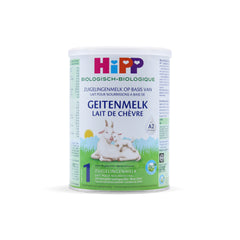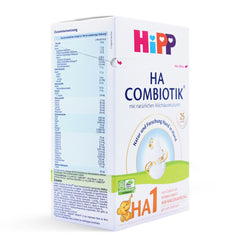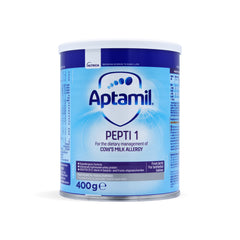Best Lactose Free Baby Formula
87 hours of research6 minute read

There are many types of baby formulas in the market and it can be challenging for parents to choose the right formula for their babies. If your baby has tummy troubles, you are probably asking: Is it lactose intolerance, cow’s milk allergy, or cow’s protein sensitivity?
Many people assume that lactose intolerance covers milk protein allergies and sensitivity – it does not. There are some similarities in symptoms and it can be confusing for parents. The best thing to do in this case is to discuss it with your pediatrician so you can get guidance on what is best for your baby.
Two common considerations when choosing a formula are lactose and milk protein. On this blog, we will answer the following questions:
- What is lactose and why is it vital in choosing a baby formula?
- What is lactose intolerance?
- What are the differences among lactose-rich, low-lactose, and lactose-free baby formula?
- What are alternatives to lactose?
- What is milk protein and why does it play a huge role if a baby will respond well to baby formula?
- What is milk protein allergy?
- What is milk protein sensitivity?
- What is the best formula of babies with milk protein allergy and milk protein sensitivity?
- What are the symptoms of the following conditions?
- Lactose intolerance
- Milk protein allergy
- Milk protein sensitivity
Lactose In Baby Formula
What is lactose and why is it important when choosing a baby formula?
Lactose is sugar that is naturally present in milk – breast milk, baby formula, and animal milk. This is an important carbohydrate for babies because this is one of the primary sources of energy for all daily activities.
What is lactose intolerance?
In order for the body to use lactose, it has to be broken down by lactase, an enzyme in the body. If the body does not produce lactase or does not produce enough lactase, the body cannot use lactose as a source of energy. The lactose in the milk cannot be digested by the body – this is commonly known as lactose intolerance. Lactose intolerance in babies is actually rare and often confused with milk protein allergies and milk protein sensitivity.
What are the differences between lactose-rich, low-lactose, and lactose-free baby formula?
| Lactose-Rich Baby Formula | Low-Lactose Baby Formula | Lactose-Free Baby Formula |
|---|---|---|
| Baby formula that is entirely lactose-based. The only carbohydrate in this type of baby formula is lactose. | Baby formula that reduced amounts of lactose. Lactose is substituted with an easy to digest vegetable oil blend beta palmitate or other easy to digest complex carbohydrate like maltodextrin that releases energy slower than simple carbohydrates |
Baby formula that does not contain lactose. The carbohydrate used in this type of formula is normally corn syrup. |
|
|
Please note that Organic Life Start does not specifically stock any Lactose-free baby formulas. |
Protein In Baby Formula
What is milk protein and why does it play a huge role if a baby will respond well to baby formula?
I. Cow’s Milk
Cow's milk is the typical (and default) source of protein in infant formula. Let's look over the many forms of cow's milk protein that are offered.
A cow's milk-based formula will contain one of two primary forms of cow's milk protein. These are casein and whey proteins. In reality, whey and casein are not two separate proteins. Each one of them represents a group of several proteins (or chains of amino acids linked together). The behavior of the two kinds of proteins in the presence of acid is what sets them apart (like stomach acid).
- Whey proteins are the ones that stay liquid after milk coagulates (curdles). Whey proteins stay "liquid" in the stomach longer than casein proteins, which causes the stomach to empty more swiftly into the intestines. Furthermore, there is less chance that whey proteins will cause allergies to flare up.
- Casein proteins take longer to digest because they curdle. Casein proteins are the key factors behind the majority of milk allergies. Casein proteins are regarded to be more "reactive" than whey proteins, making them more likely to trigger allergies or general dyspepsia.
II. Goat’s Milk
Goat milk contains higher protein content than breast milk, but it doesn’t mean that goat milk formula is dangerous for your little one. Goat milk contains naturally low levels of whey protein. Also, the protein in goat’s milk is easier to digest than cow’s milk. It is because goat’s milk protein tends to form a soft and light curd, which does not lay heavy in the stomach and digests easily.
What is milk protein allergy?
Milk protein allergy is an actual allergic reaction where the baby’s immune system treats whey and casein as foreign materials. The body then creates antibodies against the milk proteins and releases chemicals such as histamine. A small number of babies show sensitivity to cow’s milk protein.
What is milk protein sensitivity?
Milk protein sensitivity is much more common than milk protein allergy. This is based on the digestive system and is not as serious as milk protein allergy. With sensitivity, babies may eat small amounts of milk protein. Many families report that goat milk formulas, unlike cow’s milk, do not cause any trouble for their babies who have digestive problems.
What should be given to babies with milk protein allergy and milk protein sensitivity?
| Cow’s Milk Protein Allergy | Cow’s Milk Protein Sensitivity |
|---|---|
| Hypoallergenic Baby Formulas – long chain milk proteins that have been hydrolyzed into smaller pieces, excludes casein from the cow's milk. Smaller whey protein is easier to digest, and therefore has a lower risk of adverse reactions to allergenic ingredients found naturally in milk. | Goat milk – contains naturally low levels of whey protein. Also, the protein in goat’s milk is easier to digest than cow’s milk. It is because goat’s milk protein tends to form a soft and light curd, which does not lay heavy in the stomach and digests easily. Compared to cow’s milk, goat’s milk has negligible amounts of casein protein, alpha-S1. Alpha-S1 causes allergic reactions, such as cow’s milk allergy. |
Please note, the following two HiPP formulas are hydrolyzed by a factor of 86-87% and may not be suitable for all babies with CMPA. Discuss with your pediatrician before trying these formulas.
|
|
Please note: The definitions of the terms partially hydrolyzed and extensively hydrolyzed vary by country, and there is no global standard for the degree to which milk proteins are hydrolyzed in context of these labels. Aptamil Pepti Formula is hydrolyzed by a factor of 90%, while HiPP HA Formula is hydrolyzed by a factor of 86-87%. Only use these formulas under the recommendation, guidance, and supervision of your child's pediatrician.
Symptoms Of Lactose Intolerance, Milk Allergies, & Milk Sensitivity
Since the three conditions are usually confused with one another, it is important for parents to discuss their babies’ condition with their pediatricians.
Below are the symptoms of the three conditions:
| Lactose Intolerance | Milk Protein Allergies | Milk Protein Sensitivity |
|---|---|---|
|
|
|
Lactose Free Formulas & Cow Protein Sensitivity
What you feed your babies plays an important factor in their growth and development. Parents need to determine if their babies have lactose intolerance, milk protein allergies, or milk protein sensitivity so they can be given the right formula for their condition.
For babies with lactose intolerance or sensitivity to lactose, finding the right baby formula can be a challenging task. Luckily, there are lactose-free baby formula options available to provide a gentle alternative for those with specific dietary needs. Lactose-free formulas are specially formulated to be easy to digest and gentle on sensitive tummies.
Lactose, a natural sugar found in milk, is present in various dairy products, including baby formula lactose free, lactose free milk, lactose free cheese, lactose free yogurt, lactose free ice cream, lactose free cream cheese, lactose free protein powder, lactose free cottage cheese, lactose free butter, lactose free whole milk, lactose free condensed milk, lactose free chocolate milk, lactose free cream, lactose free milk powder, lactose free ricotta cheese, and lactose free heavy whipping cream. For babies who have difficulty digesting lactose, it's essential to explore lactose-free alternatives to ensure their comfort and well-being. These products allow parents to maintain a balanced diet for their little ones while addressing lactose intolerance concerns.
When choosing lactose-free dairy products or baby formula lactose free ensure to read labels and check for added sugars or artificial ingredients. Look for products that provide essential nutrients and vitamins necessary for your baby's growth and development. Consulting with a pediatrician can also be beneficial in determining the best lactose-free options for your baby's specific needs.
There are available organic options with no synthetic ingredients to aid you in making the right feeding choices for your babies.
Most Popular Low-Lactose Formulas
Organic Life Start is committed to providing accurate, reliable, and trustworthy information to parents and caregivers. We carefully choose credible sources and follow a meticulous fact-checking process to uphold the highest standards in infant nutrition and parenting advice. To learn more about our dedication to accuracy, please explore our editorial guidelines.
Link To Sources
- https://kidshealth.org/en/parents/milk-allergy.html
- https://health.clevelandclinic.org/infant-with-serious-tummy-troubles-understanding-milk-protein-allergy-and-intolerance
- https://www.webmd.com/parenting/baby/milk-allergy-vs-lactose-intolerance
- https://www.healthychildren.org/English/healthy-living/nutrition/Pages/Lactose-Intolerance-in-Children.aspx











Landry Ammons -
I’m not sure if my baby is lactose intolerant or lactose sensitive. He shows all the symptoms, though. He gets diarrhea and loose stools. Honestly, we haven’t found the perfect fit just yet, so we are still on the hunt for the right milk. I want to try HA and goat milk formulas. The start is daunting because there are so many options… I’d love to hear what you recommend starting with.
Goldie D -
November 17, 2025
I’ve always assumed that any tummy issue meant lactose intolerance, but now I see why it’s much less common than most parents think. Reading this guide helped me understand that protein sensitivity and lactose sensitivity are completely different, and the formula choice should match the actual issue. I’ve always reached for “lactose-free” as the safer option, but now I see why low-lactose or gentle formulas might be a better first step. This really opened my eyes to how important it is to check both the carb and protein source before switching formulas.
Zakai Kunz -
November 16, 2025
Finding the best lactose-free option felt like a whole journey, especially since my little darling Chari has always been sensitive to anything with too much lactose. When we tried HiPP Dutch Goat, it was the first time I saw her finish a bottle without squirming or making that uncomfortable face. Goat milk naturally has less lactose and is easier to digest, and you can honestly see the difference with her. Her tummy settled, her gas slowly disappeared, and she’s been so much happier after feeds. What I appreciate most is that it still tastes mild and creamy, so she actually enjoys drinking it — no battles at feeding time. I also love how clean the ingredients are, because it feels like such a safe choice for her sensitive little system. Since switching, her sleep stretches have gotten longer, which tells me her stomach isn’t bothering her anymore. For moms dealing with lactose troubles, HiPP Dutch Goat has truly been a lifesaver for us. I never knew a formula change could make such a big impact, but Chari is living proof.